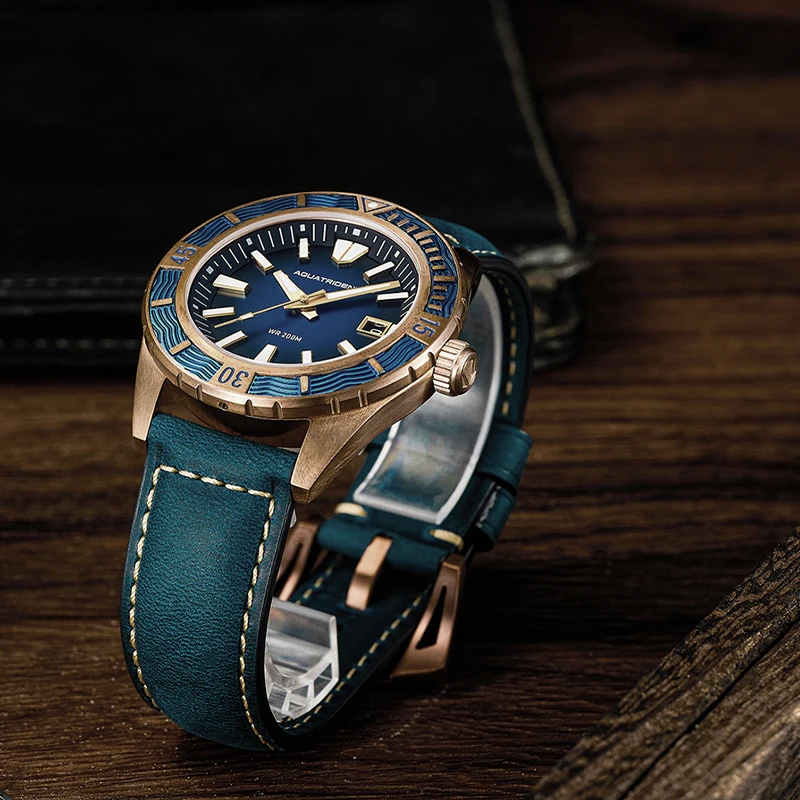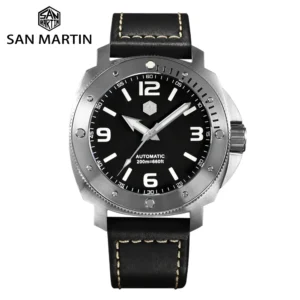The Allure of Bronze Timepieces: Understanding Your Watch
Bronze watches have captured the hearts of timepiece enthusiasts around the world with their distinctive warmth and character. Unlike stainless steel or gold, bronze is an alloy primarily composed of copper (usually 88-92%) and tin (8-12%), giving it a unique reddish-gold appearance straight from the factory.
Watch manufacturers commonly use several bronze alloy variants:
– Aluminum bronze (with 3-10% aluminum added) for improved corrosion resistance
– Phosphor bronze (containing small amounts of phosphorus) for greater durability
– CuSn8 (also known as marine bronze) with approximately 8% tin content
What makes bronze timepieces truly special is their ability to transform over time. Each watch develops its own distinct appearance based on how it’s worn and where it’s taken. This living quality creates a personal connection between the watch and its owner.
The rich maritime heritage of bronze also adds to its appeal. The material has been used for centuries in nautical equipment due to its exceptional corrosion resistance in saltwater environments. Modern watchmakers draw on this tradition when crafting dive watch engineering inspired by naval history.
For those considering adding this distinctive metal to their collection, exploring various bronze automatic watches reveals the variety of interpretations different brands bring to this ancient material.
The Science of Patina: How and Why Bronze Watches Age
Patina is the hallmark characteristic of bronze timepieces. This natural protective layer forms when the copper in bronze reacts with oxygen, moisture, and other environmental elements. Understanding the process of patina formation helps you appreciate this unique feature rather than viewing it as deterioration.
The chemical reaction is fairly straightforward: when bronze is exposed to air and moisture, the copper molecules on the surface oxidize, forming copper oxide compounds. Over time, these compounds transform into copper carbonates and copper chlorides, which create the distinctive patina colors.
The resulting patina can range dramatically in appearance:
– Early stages often show a golden-brown hue with subtle darkening
– Medium development produces rich tobacco and chocolate tones
– Advanced patina can display hints of verdigris (blue-green coloration)
What makes bronze watches particularly fascinating is that each one ages differently. A watch worn daily in a coastal climate will develop a completely different character than one worn occasionally in a dry environment. Your skin chemistry, activities, and even the seasons affect how your timepiece evolves.
Perhaps most importantly, patina actually serves a protective function. Once formed, this layer shields the underlying metal from further corrosion, acting as a natural barrier. This is precisely why bronze has been trusted for maritime applications for thousands of years.
Daily Care Essentials: Preserving Your Bronze Timepiece
Establishing simple daily habits will keep your bronze watch looking its best while allowing its character to develop naturally. These basic maintenance practices can significantly impact how long automatic watches last beyond just the bronze case.
Gentle wiping after wear: Use a clean, soft microfiber cloth to remove skin oils, moisture, and environmental residues from your watch. This prevents unwanted buildup and allows patina to develop evenly.
Keep it dry: After washing hands or exposure to water, thoroughly dry your watch with a soft cloth, paying special attention to crevices around the bezel and lugs where moisture can hide.
Handle with clean hands: Whenever possible, handle your bronze watch with clean hands to minimize oils and acids that can accelerate uneven patination.
Store properly: When not wearing your watch, store it in a cool, dry place away from direct sunlight. Exposure to UV rays can affect patina development.
Avoid harmful substances: Keep your bronze timepiece away from harsh chemicals like chlorine, cleaning products, and perfumes which can damage both the case and internal components.
These care principles apply to all fine timepieces, including automatic field military watches, though bronze requires special attention due to its reactive nature.
Basic Cleaning Techniques: Removing Dirt Without Affecting Patina
Regular cleaning removes unwanted dirt while preserving the character you’ve developed in your bronze watch. Follow these steps for effective yet gentle maintenance:
Preparation:
1. Ensure the crown is fully screwed down or pushed in to prevent water ingress
2. Remove leather straps, as they should never be exposed to water
3. Have clean towels, soft brushes, and cleaning solution ready
Cleaning Process:
1. Create a mild cleaning solution using lukewarm water with a tiny drop of dish soap (about 1-2 drops per cup of water)
2. Dip a soft toothbrush (with nylon, not natural bristles) into the solution
3. Gently brush the case in small circular motions, focusing on areas where dirt collects
4. Pay special attention to spaces between lugs and around the bezel
5. Rinse thoroughly with clean, room-temperature water
6. Immediately dry with a clean microfiber cloth, ensuring no moisture remains
This gentle cleaning approach respects the natural bronze watch patina development while removing only the unwanted grime and residue. For vintage-inspired pieces, this careful balance maintains their character while ensuring cleanliness.
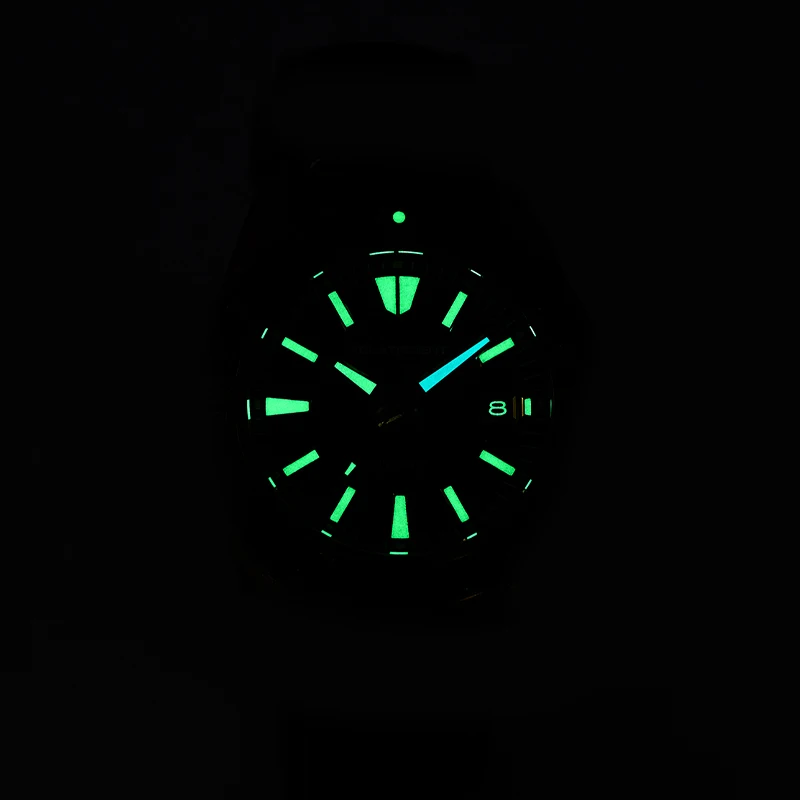
Managing Patina: Preserving the New Look
Some bronze watch owners prefer to maintain the original, bright appearance of their timepieces. If you’re looking to slow down the oxidation process, these techniques can help:
Protective Barriers:
– Apply a thin layer of Renaissance Wax (used by museums for metal preservation)
– Use watch-specific protective solutions like ProtectaClear or Everbrite
– For a budget option, a light coating of mineral oil provides temporary protection
Application Method:
1. Clean and thoroughly dry your watch
2. Apply a minimal amount of your chosen protectant to a microfiber cloth
3. Gently rub onto all bronze surfaces in circular motions
4. Allow recommended drying time (varies by product)
5. Buff with a clean cloth to remove excess
Maintenance Schedule:
– Reapply protection every 3-4 weeks for consistent results
– After water exposure, dry immediately and consider reapplication
For maximum effectiveness, store your watch in a watch box with silica gel packets when not worn, especially important for professional-spec dive watches that may experience challenging environments.
Restoration Techniques: Removing Patina Safely
When you’re ready to return your bronze watch to a newer appearance, several household methods can effectively remove patina. Each technique offers different levels of restoration:
Lemon Juice and Baking Soda Paste
1. Mix fresh lemon juice with baking soda to create a paste
2. Apply to the watch case with a soft cloth or cotton swab
3. Let sit for 10-15 minutes (not longer)
4. Gently scrub with a soft toothbrush
5. Rinse thoroughly with clean water and dry immediately
Vinegar Solution Method
1. Create a solution of equal parts white vinegar and water
2. Dip a soft cloth into the solution
3. Gently rub the bronze surfaces
4. For stubborn areas, soak a cloth and place it on the area for 5-10 minutes
5. Rinse completely and dry thoroughly
Ketchup Technique
1. Apply a small amount of ketchup to bronze surfaces (the acid works on oxidation)
2. Let sit for 10-20 minutes
3. Gently scrub with a soft brush
4. Rinse completely and dry
Toothpaste Polish
1. Apply a small amount of non-gel, non-whitening toothpaste
2. Rub gently in circular motions with a soft cloth
3. Rinse thoroughly and dry completely
IMPORTANT SAFETY CONSIDERATIONS:
– Always secure the crown before cleaning
– Remove straps before using liquid cleaning methods
– Never submerge the entire watch unless it has sufficient water resistance
– Avoid harsh chemicals and abrasives that can damage the case
– Rinse completely after any cleaning method to prevent accelerated re-patination
For detailed explanations of restoration methods from experts in the field, you can read additional insights from Horobox.
Embracing the Aged Look: Accelerating Patina Development
For those who appreciate the weathered, storied appearance of aged bronze, several methods can safely speed up the patina process that might otherwise take months or years to develop naturally. Understanding how bronze watches age naturally provides context for these acceleration techniques.
Salt Water Method:
1. Create a salt water solution (2 tablespoons of salt per cup of warm water)
2. Dip a cotton cloth in the solution and apply to the watch case
3. Let the solution sit on the surface for 5-10 minutes
4. Rinse thoroughly and dry
5. Repeat as desired until you achieve your preferred patina level
Hard-Boiled Egg Technique:
1. Hard-boil an egg and remove the shell
2. Place the egg and the watch in an airtight container
3. The sulfur compounds released by the egg will interact with the bronze
4. Check every hour until desired patination is achieved (typically 2-6 hours)
5. Remove, rinse thoroughly, and dry the watch
Commercial Products:
1. Liver of sulfur gel provides controlled patination
2. Follow product instructions precisely, as these are potent chemicals
3. Work in a well-ventilated area
4. Rinse thoroughly after application
CAUTION: Once accelerated patina is applied, it’s difficult to achieve the same even look you might get from natural aging. Consider testing on a less visible area of the watch first.
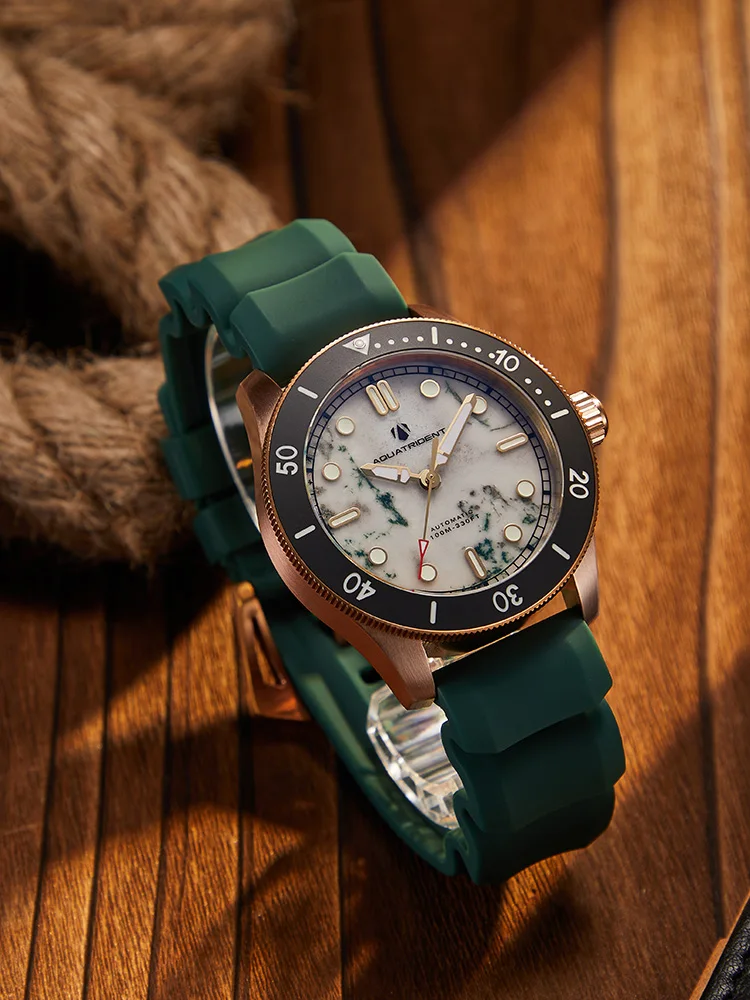
Military Inspired Automatic Watches, Rugged Automatic Watches, Tactical Automatic Watches
Price range: $852.14 through $994.60 Select options This product has multiple variants. The options may be chosen on the product pageClassic Automatic Dress Watches, Day Date Automatic Watches, Perpetual Calendar Automatic Watches
Price range: $540.60 through $574.60 Select options This product has multiple variants. The options may be chosen on the product pageAutomatic Chronograph Watches, Chronograph Pilot Watches
Price range: $233.36 through $237.58 Select options This product has multiple variants. The options may be chosen on the product pageClassic Automatic Dress Watches, GMT Automatic Watches, GMT Pilot Watches
Price range: $1,240.86 through $1,463.33 Select options This product has multiple variants. The options may be chosen on the product pageAutomatic Chronograph Watches, Classic Style Dive Watches
$3,053.06 Select options This product has multiple variants. The options may be chosen on the product pageAutomatic Skeleton Watches, Open Heart Automatic Watches
$98.36 Select options This product has multiple variants. The options may be chosen on the product page
Solving Common Bronze Watch Problems
Bronze watches can present unique challenges that don’t typically affect other watch materials. Knowing how to address these issues ensures a better ownership experience.
Green Wrist Syndrome:
* Cause: Copper compounds from the bronze transferring to skin
* Solution: Choose watches with stainless steel casebacks or apply clear nail polish to the caseback
* Prevention: Remove watch during heavy perspiration and clean both wrist and watch after wear
Normal Patina vs. “Bronze Disease”:
* Normal patina: Even coloration ranging from brown to green, stable surface
* Bronze disease: Powdery light green spots, pitting, or flaking – requires immediate attention
* If true bronze disease is suspected, consult a professional immediately
Uneven Patination:
* Cause: Inconsistent exposure to elements or handling patterns
* Solution: Complete patina removal and fresh start, or accelerated patination to even appearance
* Prevention: Consistent wearing patterns and regular cleaning
Minor Scratches:
* Bronze scratches can often blend with patina over time
* For deeper scratches, light polishing with a jeweler’s cloth before patina forms can help
* Consider scratches part of your watch’s unique story and character
Those interested in the technical aspects of bronze watch cases can find more information in our definitive guide to bronze watch cases. For watches designed to handle tough conditions, our collection of rugged automatic watches provides excellent options.
Beyond the Case: Caring for Other Watch Components
While the bronze case receives most attention, proper maintenance of other watch components ensures overall longevity and performance:
Crystal Care:
* Clean with microfiber cloth and diluted eyeglass cleaner
* Check for scratches that might compromise water resistance
* For acrylic crystals, use polywatch polish to remove minor scratches
* For sapphire, avoid impact as it’s scratch-resistant but can shatter
Movement Protection:
* Keep crown screwed down when not in use
* Avoid magnetic sources that can affect timekeeping
* Consider regular service intervals (typically 3-5 years)
* Listen for unusual noises that might indicate movement damage
Strap Maintenance:
* Leather: Keep dry, clean with leather conditioner, store flat
* Rubber: Rinse after salt water exposure, avoid prolonged sun exposure
* NATO/fabric: Machine wash occasionally, air dry completely
* Metal bracelets: Clean with soft brush and mild soap solution
Water Resistance:
* Have gaskets checked annually if using for water activities
* Replace gaskets during regular service
* Test water resistance before summer/swimming season
* Rinse with fresh water after ocean or pool exposure
When to Seek Professional Help: Service and Maintenance
While many aspects of bronze watch care can be handled at home, certain situations call for professional expertise:
- Movement service: When accuracy declines or every 3-5 years
- Water resistance failure: If moisture appears inside the crystal
- Severe oxidation issues: When home remedies can’t resolve problematic patina
- Bezel or crown functionality problems: When components become difficult to operate
- Case damage: Dents or deformations that affect structural integrity
When selecting a watchmaker for your bronze timepiece, ensure they have specific experience with bronze watches. Not all professionals understand the unique properties of this material and may attempt unnecessary polishing or treatments.
The evolution of dive watch technology has led to more complex water-resistant systems that require specialized knowledge to service properly. When in doubt, consult the manufacturer’s recommendations for service intervals and approved service centers.
Bronze Watch Storage Solutions for Controlled Aging
Proper storage significantly impacts how your bronze watch ages when not on your wrist:
Ideal Environmental Conditions:
* Temperature: 65-75°F (18-24°C)
* Humidity: 40-50% (use hygrometer to monitor)
* Avoid direct sunlight exposure
* Keep away from bathroom moisture and kitchen chemicals
Recommended Storage Options:
* Dedicated watch boxes with individual compartments
* Silica gel packets to absorb excess moisture
* Watch winders for automatic watches (set to appropriate TPD)
* Anti-tarnish strips or cloth can help control oxidation
Pre-Storage Preparation:
1. Clean the watch thoroughly
2. Ensure it’s completely dry
3. Apply protective coating if desired
4. Wind manual watches; let automatics run down unless using a winder
For field watches that may face challenging conditions, proper storage between adventures is particularly important. Our collection of classic field watches includes models designed with durability in mind.
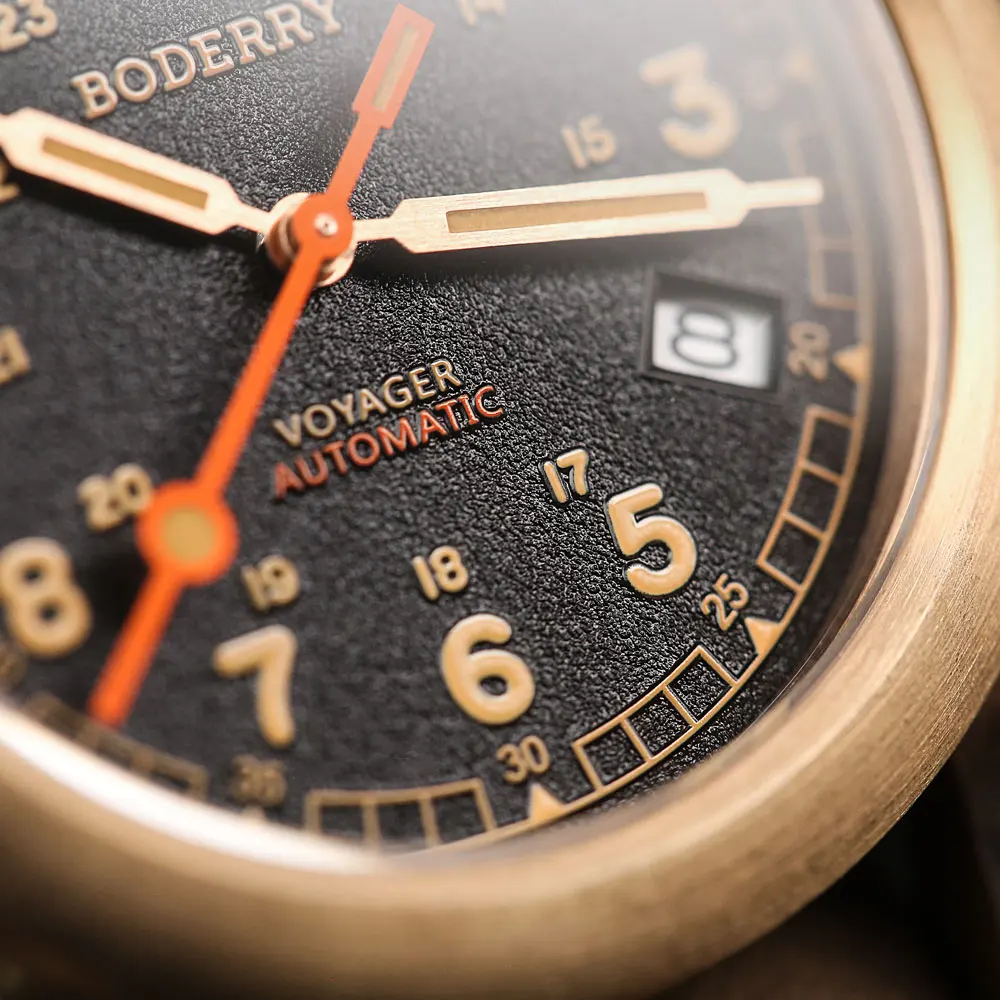
Are Bronze Watches Right for Everyone? Considerations Before Purchase
Bronze watches offer a unique ownership experience, but they’re not necessarily suited for every collector:
Who typically enjoys bronze watches?
People who appreciate the evolution and story-telling aspect of watches, those who value uniqueness over uniformity, and collectors who enjoy interacting with their timepieces beyond simply wearing them.
Maintenance commitment?
Bronze requires more attention than stainless steel but less than silver. The level of maintenance depends largely on your preferences for patina development.
How does lifestyle affect ownership?
Active, outdoor lifestyles accelerate patination. Frequent swimming, especially in salt water, dramatically speeds up the aging process. Office environments typically result in slower, more subtle changes.
Common misconceptions?
Bronze watches don’t “deteriorate” – they transform. The patina is not damage but a protective layer that gives each watch its character. Also, bronze is actually quite scratch-resistant compared to many other watch materials.
For those seeking alternatives, our collection of automatic watches offers excellent options in various materials.
The Collector’s Perspective: Curating a Bronze Watch Collection
Serious collectors often develop sophisticated approaches to bronze watch ownership:
Many collectors maintain different patina levels across their collection – allowing some pieces to develop rich, dark patinas while keeping others closer to their original state. This creates a visual timeline of bronze’s aging capability.
Documentation has become a popular practice, with collectors photographing their bronze watches at regular intervals to capture the transformation journey. These photo series become part of the story and value of the timepiece.
Display considerations also matter. Some enthusiasts create microclimates within watch boxes using moisture-controlling elements to develop specific patina types. Others rotate their collection through different wearing schedules to ensure balanced aging.
The contrast between bronze and other materials makes for a visually striking collection. The warm tones of bronze complement the cool appearance of steel and titanium watches, creating a balanced collection aesthetic.
Your Bronze Watch Journey: Concluding Thoughts on Ownership
Owning a bronze watch is more of a journey than a destination. Unlike most timepieces that strive to look the same day after day, your bronze watch evolves alongside you, recording your experiences in its changing appearance.
There’s no “correct” level of patina – the perfect appearance is the one you personally find most appealing. Some owners prefer the bright, fresh look of new or recently-polished bronze, while others cherish the deep, rich tones of aged patina that can only come with time.
Your bronze timepiece becomes uniquely yours in a way few other possessions can. The places you go, the activities you enjoy, and even your body chemistry all contribute to its unique character.
This partnership between owner and object represents the true essence of what makes mechanical timepieces special in our digital age – they don’t just tell time; they tell your story.

